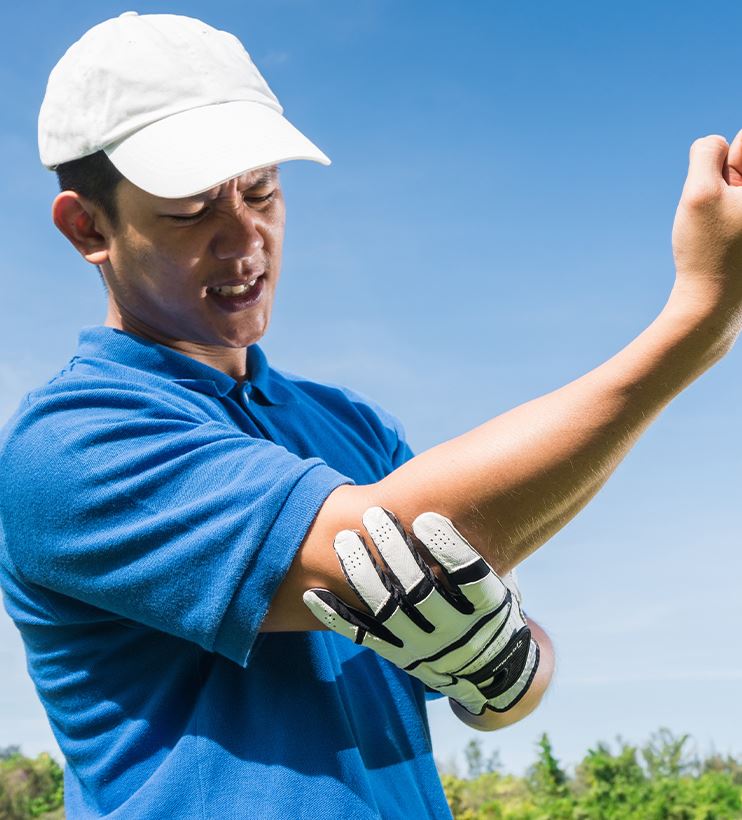

Elbow
OSS is focused on the elbow.
Dr. Michael Moses is a fellowship-trained orthopaedic surgeon who routinely treats the elb for the elbow.
Non-Surgical Treatments
OSS doctors always start with the most conservative approach (in other words, the least invasive to your body and lifestyle) to help you ease the elbow pain and improve how you move. Our doctors often prescribe most elbow pain with rest, ice or heat, prescription medications, splinting or bracing (casting), injection therapy (corticosteroid, PRP), and/ or hand therapy (OSS offers physical and hand therapy).
Common Surgeries
Soft Tissue Repair in Elbow
Tennis Elbow, Golfers’ Elbow
Soft Tissue Surgery around the elbow includes cubital tunnel release, Tenex procedure and repairs to the biceps / triceps.
- In Cubital Tunnel Syndrome (ulnar nerve compression), the ulnar nerve becomes compressed or irritated and causes numbness, weakness and/or pain in the forearm and hand. The surgical procedure used takes some form of “decompression” or relief of pressure on the nerve. Regardless of the method used, this procedure generally is done same day, allowing you to go home after the surgery.
- The Tenex Procedure is a minimally invasive technique that is used to treat tennis elbow (lateral epicondylitis) and golfer’s elbow (medial epicondylitis). This procedure is ideal for patients who are suffering from chronic tendon pain by removing the damaged scar tissue on the tendons. This minimally invasive procedure is typically performed at our surgery center using local anesthesia. The benefits of this procedure include fast symptom relief and a speedy recovery.
Repair an Elbow Fracture
Sometimes casting or bracing is not enough to fix a broken bone in the elbow and “trauma” surgery is required to repair the elbow injury. OSS orthopaedic doctors have many years of training working in large city hospitals that tends to receive many emergencies like broken elbows.
Elbow Scope (Elbow Arthroscopy)
Elbow scope surgery is a minimally invasive surgery because the incisions made around the elbow joint are small. An arthroscopic surgery allows your surgeon to use a long, thin light instrument called an arthroscope to see and work inside your elbow joint.
Elbow Replacement (Elbow Arthroplasty)
The main reason a joint needs to be replaced is arthritis. Different types of arthritis can include osteoarthritis (wear from years of use), inflammatory arthritis (chronic joint disease), post-traumatic arthritis (fracture, broken bone in the elbow joint). OSS orthopaedic surgeons will replace your elbow by replacing it with an artificial joint called a prosthesis. The benefits of elbow replacement surgery include: relief from pain, more movement and improved use over time.
Common Problems
- Sprains and Dislocations Injury from sports or an activity which causes stress on the elbow joint can injure the ligaments, causing a sprain. A significant injury can rupture the elbow ligaments completely causing a dislocation.
- Tendinitis and tendon ruptures. Tennis elbow (lateral epicondylitis) and golfers’ elbow (medical epicondylitis) are very common. These accrue after repetitive injury (or an acute injury) to the tendon causes degeneration. The pain can be aggravated by lifting and gripping. Tendon ruptures are most commonly seen in middle aged men and in competitive weightlifters, bodybuilders or football players. The distal biceps tendon is most commonly injured
- Fractures. One or more of the 3 bones in the elbow becomes fractured or broken. (A fractured bone is typically considered to be a sudden trauma). The broken bone in the elbow can be very painful since the elbow has less muscles and tissues around it.
- Arthritis. Arthritis occurs when the cartilage surface of the elbow is worn or damaged. This can be the result of wear and tear over the years or following elbow trauma, such as a fracture or dislocation. develops over time in the elbow joint.
- Nerve entrapment. Nerves that cross the elbow can sometimes be pinched or entrapped by muscle and other soft-tissue. Arthritis and other inflammatory conditions can also cause nerve irritation.
Complete Approach to Surgery
Smart + Safe
The OSS hand, wrist and elbow surgeons routinely use minimally invasive surgical techniques.
The doctors perform the procedures in a surgery center or in a hospital. Our physician anesthesiologists at either the surgery centers or hospitals are highly trained and work closely with OSS to give you the best and safest experience. OSS will monitor your recovery progress remotely through an application. The benefit is our medical team will make sure your recovery is on the expected path once you are home and we will be alerted if we need to adjust the recovery plan.
Most of the surgeries we routinely do are “same day” surgeries, allowing you to return home later in the day. Of course, we offer the option of an overnight stay if you and your doctor determine it’s needed.
We Stay Involved AFTER Surgery
First, we will help you plan out the details, so you know what to expect and how to be involved. Second, in addition to your follow up care appointments in our office, OSS also monitors your recovery remotely through OutcomeMD. The benefit is our medical team will make sure your recovery is on the expected path once you are at home and we will be alerted if we need to adjust the plan. Next, we will help you manage the after-surgery pain safely and help you plan for the at-home routines, including how to use recovery aids. Also, we will help you get connected with the OSS hand therapy team, so you rebuild your strength and mobility.
Trusted Medical Sources
To find out more about elbow injuries, please visit American Academy of Orthopedic Surgeons:
Description of the Elbow
The elbow is comprised of 3 bones: the humerus (upper arm bone), and the radius and ulna (which together make up the forearm) and is primarily controlled by the bicep and triceps muscles. You may have bumped your “funny bone” once or twice in your life. In actuality, you bumped the ulnar nerve.
The elbow, made up of 3 bones that come together to form the elbow joint, plays a key role in positioning your hand correctly. Because the elbow (in medicine, we refer to this body part as olecranon) connects your hands and arms, the elbow is not only susceptible to injury from a sudden trauma, but the elbow often over-compensates for injuries to other parts of upper extremity (from shoulder to fingers).

